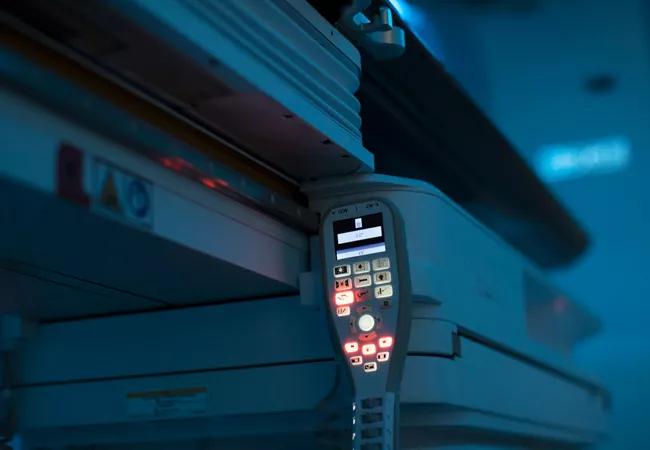A novel strategy for radiation therapy planning

In a study published recently in Medical Physics, Jacob G. Scott, MD, DPhil, radiation oncologist in the Department of Translational Hematology and Oncology, and his team of collaborators introduced a novel strategy of radiation therapy planning called temporally feathered radiation therapy (TFRT). The study presents a theoretical model and rationale behind TFRT that allows increased time for normal tissue recovery between radiation doses.
Advertisement
Cleveland Clinic is a non-profit academic medical center. Advertising on our site helps support our mission. We do not endorse non-Cleveland Clinic products or services. Policy
Dr. Scott hopes this new strategy will aid the efforts aimed at reducing normal tissue toxicity due to radiation therapy.
“I am quite hopeful that in select patients, this approach will allow for equivalent therapy with less toxicity as well as isotoxic dose escalation, which would ensure less toxicity with a smaller dose of radiotherapy or, alternatively, the same level toxicity with an increased dose of radiation for those patients who might need dose escalation,” Dr. Scott explains. He adds that “TFRT aims to widen the therapeutic window by taking the advantage of our understanding of the temporal aspect of tissue repair.”
TFRT is based on varying the fractional radiation dose delivered to each organ at risk (OAR) to allow for increased time for normal tissue repair of radiation-induced damage.
“The novel aspect of our study is the optimization of radiation dose over time with respect to the surrounding normal tissues,” says Shireen Parsai, MD, a radiation oncology resident and co-author of the study.
According to Dr. Parsai, TFRT is an extension of IMRT planning in which the daily fractional dose delivered to each OAR is varied.
“In this way we deliver one marginally higher fractional dose of radiation once weekly to each OAR followed by four lower fractional doses. We hypothesize that with increased time between larger fractional doses there is increased normal tissue repopulation and repair,” she says.
Dr. Parsai further explains that TFRT provides five different radiation plans, one for each day of the week, unlike the conventional radiotherapy planning approach where radiation plans do not differ between treatment days.
Advertisement
“Because it is more time consuming to create five different plans, we are now in the process of automating this system and optimizing five plans at once,” she says.
Dr. Scott’s team is currently working on a paper that provides a more formal comparison between TRFT and the conventional radiotherapy planning approach, in preparation for TRFT testing in a clinical setting.
“We’re looking at how feasible these plans are and how long it takes to prepare them and trying to determine in which groups of patients they would be most beneficial,” Dr. Scott says. “This is a step toward defining the selection criteria for TFRT.”
As a next step, his team plans to test TRFT in the scope of “a prospective trial where patients would be able to choose between the conventional radiotherapy planning approach and TRFT. This would allow for us to test feasibility of planning as well as acute and long-term toxicity, while assuring therapeutic equipoise.”
“We are currently in the clinical study planning phase and would like to start recruiting patients with head and neck cancer,” adds Dr. Parsai. “We are aiming to gather patient-reported outcomes in addition to the objective physician-recorded parameters of toxicity. We are optimistic that we will observe reduction in toxicity clinically with this new technique.”
Photo credit: Russell Lee
Advertisement
Advertisement

Radiation oncology department finds weekly plan of care meetings have multiple benefits

Identifying candidates for further screening and treatment

Screening also found to be cost-effective

Research highlights promising outcomes for treating recurrent and metastatic cases

Correlation found between the biomarker HSD3B1 and resistance to combined hormone therapy and radiotherapy

Meta-analysis suggests efficacy and safety

Transperineal ultrasound a viable, non-invasive option for monitoring intra-fractional prostate motion

Multidisciplinary team to examine radiation therapy combined with immunotherapy